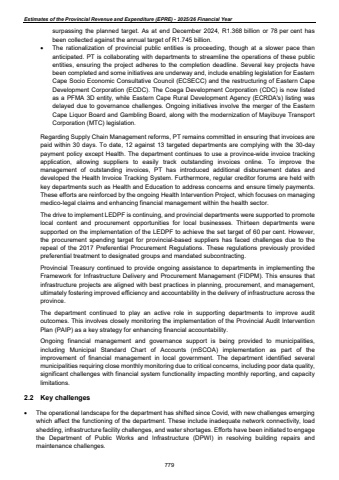Page 800 - Demo
P. 800
Estimates of the Provincial Revenue and Expenditure (EPRE) - 2025/26 Financial Year surpassing the planned target. As at end December 2024, R1.368 billion or 78 per cent has been collected against the annual target of R1.745 billion. %uf0b7 The rationalization of provincial public entities is proceeding, though at a slower pace than anticipated. PT is collaborating with departments to streamline the operations of these public entities, ensuring the project adheres to the completion deadline. Several key projects have been completed and some initiatives are underway and, include enabling legislation for Eastern Cape Socio Economic Consultative Council (ECSECC) and the restructuring of Eastern Cape Development Corporation (ECDC). The Coega Development Corporation (CDC) is now listed as a PFMA 3D entity, while Eastern Cape Rural Development Agency (ECRDA's) listing was delayed due to governance challenges. Ongoing initiatives involve the merger of the Eastern Cape Liquor Board and Gambling Board, along with the modernization of Mayibuye Transport Corporation (MTC) legislation. Regarding Supply Chain Management reforms, PT remains committed in ensuring that invoices are paid within 30 days. To date, 12 against 13 targeted departments are complying with the 30-day payment policy except Health. The department continues to use a province-wide invoice tracking application, allowing suppliers to easily track outstanding invoices online. To improve the management of outstanding invoices, PT has introduced additional disbursement dates and developed the Health Invoice Tracking System. Furthermore, regular creditor forums are held with key departments such as Health and Education to address concerns and ensure timely payments. These efforts are reinforced by the ongoing Health Intervention Project, which focuses on managing medico-legal claims and enhancing financial management within the health sector. The drive to implement LEDPF is continuing, and provincial departments were supported to promote local content and procurement opportunities for local businesses. Thirteen departments were supported on the implementation of the LEDPF to achieve the set target of 60 per cent. However, the procurement spending target for provincial-based suppliers has faced challenges due to the repeal of the 2017 Preferential Procurement Regulations. These regulations previously provided preferential treatment to designated groups and mandated subcontracting. Provincial Treasury continued to provide ongoing assistance to departments in implementing the Framework for Infrastructure Delivery and Procurement Management (FIDPM). This ensures that infrastructure projects are aligned with best practices in planning, procurement, and management, ultimately fostering improved efficiency and accountability in the delivery of infrastructure across the province. The department continued to play an active role in supporting departments to improve audit outcomes. This involves closely monitoring the implementation of the Provincial Audit Intervention Plan (PAIP) as a key strategy for enhancing financial accountability. Ongoing financial management and governance support is being provided to municipalities, including Municipal Standard Chart of Accounts (mSCOA) implementation as part of the improvement of financial management in local government. The department identified several municipalities requiring close monthly monitoring due to critical concerns, including poor data quality, significant challenges with financial system functionality impacting monthly reporting, and capacity limitations. 2.2 Key challenges %uf0b7 The operational landscape for the department has shifted since Covid, with new challenges emerging which affect the functioning of the department. These include inadequate network connectivity, load shedding, infrastructure facility challenges, and water shortages. Efforts have been initiated to engage the Department of Public Works and Infrastructure (DPWI) in resolving building repairs and maintenance challenges. 779


